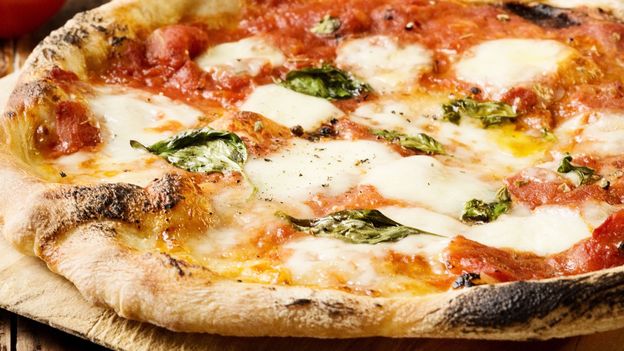核心概念
The author explores the rich history and tradition of Neapolitan pizza-making, emphasizing the importance of authentic ingredients and techniques passed down through generations.
要約
Neapolitan pizza, a beloved Italian dish, holds cultural significance with its unique origins in Naples. The traditional pie varieties, Margherita and marinara, reflect historical influences like the introduction of tomatoes from Peru. The meticulous preparation process and adherence to specific criteria by pizzaiolos ensure the authenticity of Neapolitan pizza. The legacy of iconic pizzerias like Gino e Toto Sorbillo continues to promote Naples' culinary heritage worldwide.
How to make pizza like a Neapolitan master
統計
Naples has over 500 pizzerias, but only a fifth are certified by the True Neapolitan Pizza Association.
Franco Pepe from Pepe in Grani has won the best pizza maker contest for three consecutive years.
Ciro Salvo emphasizes that dough fermentation for Neapolitan pizza must be at least 10 to 12 hours.
Only two types of mozzarella are used for Neapolitan pizza: fior di latte or mozzarella di bufala.
The dough for Neapolitan pizza must be no more than 3mm thick and bake at a high temperature of 485°C.
引用
"It’s [how you make] the dough that’s essential." - Gino Sorbillo
"I am lucky. It’s not just my work but my passion and my life." - Ciro Salvo
抽出されたキーインサイト
by 場所 www.bbc.com 04-15-2020
http://www.bbc.com/travel/story/20200415-how-to-make-pizza-like-a-neapolitan-master
深掘り質問
What impact does the UNESCO recognition have on preserving Neapolitan pizza's cultural heritage?
The UNESCO recognition of Neapolitan pizza as an intangible cultural heritage item plays a significant role in preserving its cultural heritage. This acknowledgment brings attention to the traditional methods, ingredients, and techniques involved in making authentic Neapolitan pizza. It helps raise awareness about the historical significance of this culinary tradition and encourages efforts to safeguard it for future generations. The designation also promotes respect for the craftsmanship and expertise of pizzaiolos who have mastered the art over generations. By highlighting the cultural value of Neapolitan pizza, UNESCO recognition contributes to its continued practice and ensures that it remains an integral part of Italy's gastronomic identity.
Is there room for innovation in traditional Neapolitan pizza-making techniques?
While traditional Neapolitan pizza-making techniques are deeply rooted in history and culture, there is indeed room for innovation within this culinary tradition. Pizzaiolos can explore creative variations while still adhering to the fundamental principles that define authentic Neapolitan pizza. Innovations may involve experimenting with different toppings, sauces, or cheese varieties while maintaining the essential characteristics such as using Italian 00 or 0 wheat flour, fresh brewer’s yeast, water, salt, specific types of tomatoes like San Marzano, and mozzarella di bufala or fior di latte.
Innovation can also extend to baking methods and equipment used in preparing Neapolitan pizzas. While wood-burning ovens are traditionally preferred for their ability to achieve high temperatures quickly, modern technologies like gas-fired ovens with stone surfaces can offer consistency and efficiency without compromising on quality. Ultimately, innovation should complement tradition by enhancing flavors and textures while respecting the core elements that make Neapolitan pizza unique.
How does the globalization of Neapolitan pizzerias influence perceptions of Italian cuisine abroad?
The globalization of Neapolitan pizzerias has a profound impact on shaping perceptions of Italian cuisine abroad by showcasing authenticity and excellence in culinary traditions. As these pizzerias expand internationally, they serve as ambassadors for Italian gastronomy by introducing foreign audiences to genuine flavors and techniques associated with Neapolitan pizza-making.
By upholding strict standards set by organizations like True Neopolitan Pizza Association (VPN), global pizzerias maintain a commitment to using quality ingredients sourced from Italy along with following traditional preparation methods approved by experts in Naples. This dedication not only preserves the integrity of Italian cuisine but also elevates its reputation worldwide.
Furthermore, through exposure to authentic experiences at renowned establishments like Gino e Toto Sorbillo or Pepe in Grani outside Italy's borders,
people develop a deeper appreciation for regional specialties beyond just popular dishes like pasta or risotto.
This exposure fosters cultural exchange,
encourages culinary tourism,
and enhances international understanding
of Italy's rich food heritage.
Overall,
the globalization
ofNeopolitanpizzeriassignificantly influencesperceptionsofItaliancuisineabroadbyemphasizingqualitytradition,andcraftsmanshipinapopularandaccessibleformat
0
